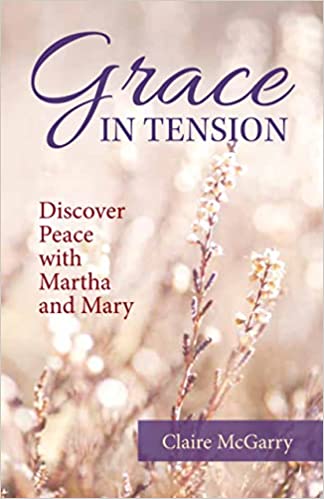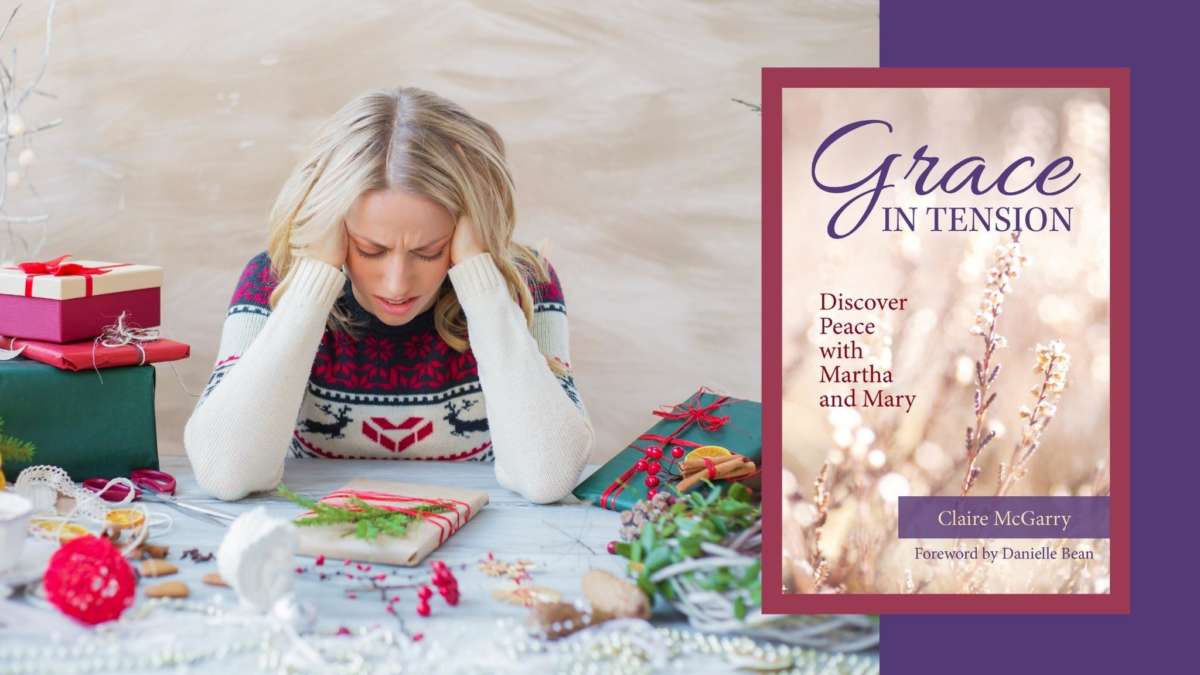Grace in Tension: Discover Peace with Martha and Mary by Claire McGarry
“Recommended for anyone struggling with ‘doing’ over ‘being.’” —Rev. Dr. Lawrence Jay
“If you have never thought of stress as a gift, pray this book.” —Sister Bridget Haase, OSU, author of Thirty Days Praying the Imitation of Christ
“A powerful, proactive prescription!” —Lisa M. Hendey, author of The Grace of Yes
—∞—
As a biographer and researcher, I annotate books often, underscoring paragraphs and writing notes and questions in the margins, all to learn more about the person I am studying. Ebooks make it particularly easy to add comments related to highlighted passages.
However, every once in a while, I come across a work with which I must engage in conversation. Such a back-and-forth dialogue is the next best thing to talking with the author directly; this is what journaling a book is all about.
Claire McGarry’s debut publication titled Grace in Tension: Discover Peace with Martha and Mary (Our Sunday Visitor) moved me to this more profound reading experience. The book considers two sisters in the Bible who were close friends of Jesus and how we can learn from them to deepen our relationship with God. I felt compelled to talk back to this book as I discovered insights that inspired me to ponder and examine my spiritual life.
TWO SISTERS, TWO APPROACHES: DOING VERSUS BEING
Martha and Mary approach life from opposite angles. Many women identify with Martha, the “doer” with the never-ending list of tasks. Always striving to please, “Marthas” sometimes lose their way in the process. Then there is Mary, the one with whom I identify: quiet, perhaps too passive, and yet thoughtful. The sisters behave as prescribed as we meet them for the first time in Luke, chapter 10. Martha becomes overwhelmed with meal preparation for their special guest. She resents Mary, who has chosen to sit at the feet of Jesus and listen rather than help her sister. Jesus gently chides Martha for being “worried and distracted over many things;” he believes Mary “has chosen the better part” and does not want her to be disturbed. By his loving rebuke, he is inviting Martha to experience the same.
The book’s central theme is tension — the stress we feel when our lives are out of kilter due to hardships or just having too much to do, and how God uses such pressure to help us regain our balance again. Martha and Mary are perfect characters for a study of stress and how it can affect us. They also show how aligning themselves with the Lord changes tension into a positive and transformative experience.
From this passage and two others that follow, McGarry writes a penetrating and eminently practical analysis with tools to help readers apply these lessons to their lives. Each chapter ends with a prayer and the G-I-F-T formula, a process she discovered in helping her implement what she learned. G-I-F-T stands for Gauge, Invite, Filter, and Transform. McGarry writes, “God gave me clear insight into my problem and clear direction on how to fix it. In just twenty minutes of spending time at his feet, he helped me see the gift that was tucked inside all that tension. The crazy thing is, when I look back over the experience, I realize that the process … spells the word gift.”
CONVERSING WITH THE CONCEPTS AND CHARACTERS
Here are some of the conversations I conducted with Grace in Tension:
—∞—
From the Introduction, referring to Martha’s anger at Mary for not helping her: “I was getting upset on Martha’s behalf because I was being defensive. I was trying to advocate for her being right because that would make me right too.”
My response: It’s about pride. We think we are justified in feeling the way we do, making it hard to let go.
—∞—
From the Introduction. “Tension will always rear its ugly head. Therefore, unless it’s going to put us in moral or spiritual danger, why not move toward it rather than away? Why not shift our perspective and see it as a place for new growth versus a cross or a curse? Why not use tension as a bridge to reverse our direction when we’ve chosen the wrong response, crossing back to the place where we can choose again?”
My response: I love this! Embracing tension as a tool removes the burden of guilt because you’re using something negative to produce something beneficial.
—∞—
From Chapter Two. “This happens most when our Martha-like tendencies have us fixating on doing rather than on being, succumbing to the way the world defines success and progress rather than how God does.”
My response: Although my preference is towards being, I feel pressured into doing so as to have something concrete to show for it.
—∞—
From Chapter Three, establishing boundaries so that we do not become overwhelmed with tension, as did Martha. “The same holds true for our personal boundary lines. We need to discern for ourselves what our top priorities are, then dig those posts deep into our daily lives. The more fixed and focused we make them, the more our activity and choices will flow from them.”
My response: My most important boundary is guarding against getting overly busy. Once I commit to something, I find it hard to withdraw without immense guilt. So it’s best to say “no” from the start.
—∞—
From Chapter Seven. “As we spend time with God, he’ll remind us of the tasks that only we can do. From there, it’s easy to see what can be done by others.”
My response: This is also a critical lesson for the elderly who will need help when the time comes and often spurn that help out of pride, not having taken the time to ponder the lesson of humility and accept assistance. As we need to prepare financially for old age, we also have to prepare spiritually. I take this consideration seriously as I’m entering that phase myself.
—∞—
From Chapter Seven. “The effects of returning to the same space and spending time with God there is astounding! The more we do it, the stronger and faster the connection with God gets.”
My response: In the early days of Parkinson’s, when my whole body would shake, I would lie on my back with my head slightly elevated and clutch my pillows to still my body. Then I would listen to Bishop Reed on CatholicTV chant the Divine Mercy prayer; the stillness would spread to my interior, often resulting in my falling asleep. Now that I am on medication, I don’t need to do this anymore. But I do it anyway because I never felt closer to God than when I prayed in this way.
—∞—
If you have never journaled a book before, or even if you do so regularly, and you are looking to deepen your relationship with God through the example of these two women, I highly recommend trying Grace in Tension: Discover Peace with Martha and Mary. It’s a rejuvenating and inspiring interactive reading experience.
Photo credit: Gina Brannon, Sweet Love Studios




